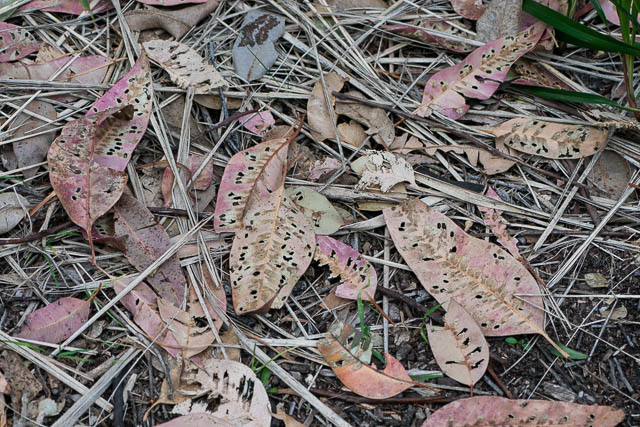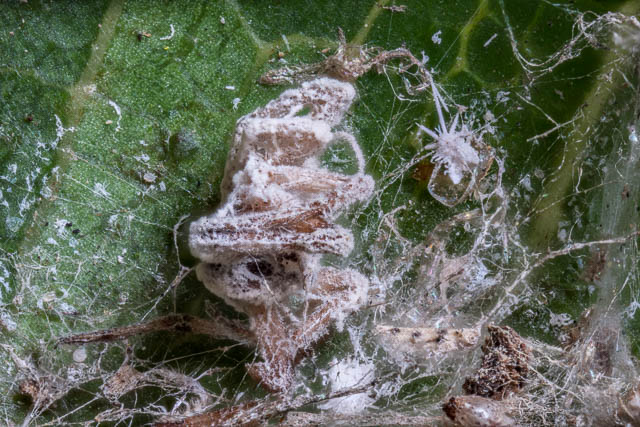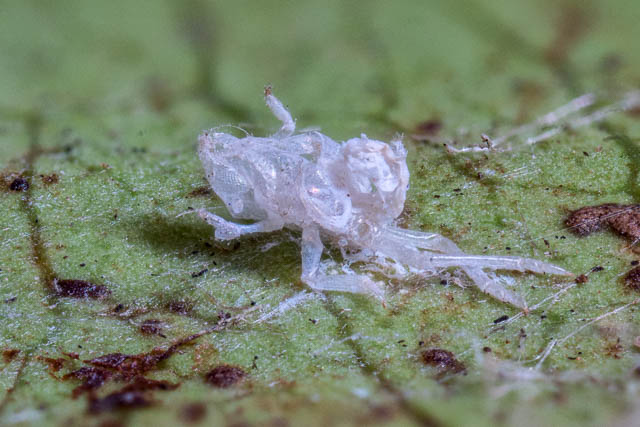I thought it was about time I did some macro-photography. I had recently seen some of Steven Axeford’s recent photos of small spiders infected with a cordyceps type of fungus that he had found on the back of leaves. These spiders were all very small – about 2 mm across. And asking him about the leaves he had found them on, it seemed that it is worth looking at all types of leaves – ones still on trees, ones on he ground etc. The important thing is you need to look at a lot of leaves to find the infected spiders.

I did not have too much success finding spiders infected with cordyceps, but I did have an interesting time looking at the amazing ecosystems on the back of leaves.
I will start with some holes in leaves. I had seen Eucalyptus leaves at Tempe Wetlands that had a series of holes made either by insects on the leaves or by birds removing those insects to eat. More recently, I had seen these same pattern of holes at Gough Whitlam Park on the Cooks River.




It was then that I started looking at these leaves to see if I could find the cause of these holes. I looked at a lot of leaves – both fallen and fresh and could not find any bugs on the leaves. The leaves were either riddled with holes or they were fresh and had none. So, perhaps what makes the holes could appear seasonally.
I also looked at other leaves. Here are some of my macro-photos.
I found a few of these small insects. Perhaps some type of Mealy Bug?


And on the same leaf, some other bugs that were much smaller –

Perhaps the smaller ones were a juvenile form of the larger ones?
I also found a few of these structures –


It seems that they are made by scale insects. Perhaps wax-scale insects.

The one above is probably a Wax Scale insect in the Family Coccidae.

This next photo is interesting –

There seems to be a large spider type creature, and on the upper right, there is this –

This looks like a spider that has been infected with a cordyceps type of fungus. The fungus that has infected the creature could be Gibellula pulchra or similar.
Here are some small exoskeletons –

Perhaps some type of Lerp – moulted shell?



These were larger and on the underside of fig leaves –

Some more –

I found this small creature with a big pile of baggage. Perhaps it accumulates all the junk to hide under? It was still alive and moving too fast for focus stacking.

And this very regular structure –

This is about 3 mm across. Perhaps a spider web? On the underside of a leaf. Mid right – looks like a spider infected with a cordyceps like fungus, and perhaps also some small red spider mites.
Most of these photos have been taken using an extreme macro lens (2.5 – 5 x magnification) with the camera mounted on an automated rail. For each a series of photos, often 30 to 50 images, then they were combined on computer (focus stacking).
There is a whole new world here for me to explore.
Update (13 October 2021) – I should have looked at one of my reference books (Insects of South-Eastern Australia, Roger Farrow, CSIRO), which has a photo of a leaf with holes very similar to the one I have taken above. According to that book, the holes are made by leaf miners. These are caterpillars (Lepidoptera – family Incurvariidae). The larvae feed off the leaf. When they reach maturity the cut around the perimeter of the mine, and the section falls off leaving the hole in the leaf. The larvae then pupates in the detached mine. This makes sense, but I had looked at a lot of leaves and not seen the caterpillars, nor the blisters they form on the leaves. Perhaps some of what I thunk are lerps could be those blisters? And another observation. You can see from the photos that many many leaves have these holes. I would expect to see the creatures that made them. But they could be seasonal, and I may have been looking at the wrong time. More to explore.

Wow! I recently watched a Netflix documentary called ‘Fantastic Fungi’ and within the film they discussed the potentials of fungi and how it is a form of both medicinal practice for human beings and the saviour to Earth and our problems to climate change ! Then they started talking about the term mycophile and it made be so fascinated to see what these people discuss and discover and I wondered whether Sydney had a mycophile club and THEN I STUMBLED UPON SFSCI and your name being one of the coordinators. Once COVID lockdown eases and we are “back to normal” I would love to meet, discuss and explore wild life and the amazing wonders of fungi in Australia by joining the club !
On a side note sorry for keeping this comment so long ! But I am absolutely loving to read these blogs that you have documented over the course of time
Thank you for sharing wonderful world of tiny bugs!
The ones which you guessed may be the juvenile form have eight legs but the first insect has only six! The tiny ones remind me of ticks.